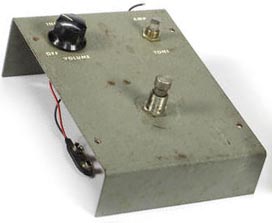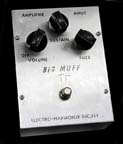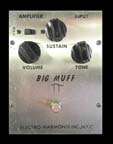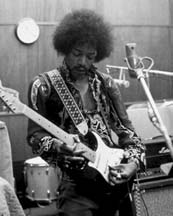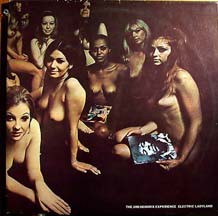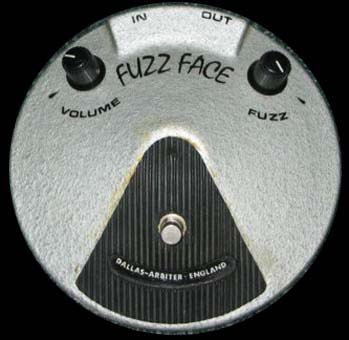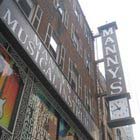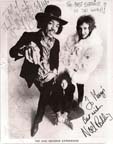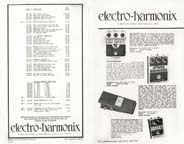The Big Muff π Page
The Definitive Big Muff Resource and History
VISIT MY SWORDS, KNIVES and FANTASY ART WEBSITE www.kitrae.net
Last update October 2014
An interesting bit of Big Muff history is the legend that Jimi Hendrix got his sound from the Big Muff. This story was perpetuated by Electro-Harmonix in their own marketing literature throughout the 1970s, claiming this as the pedal Jimi relied on for his "electric-lady" sound. As a Big Muff fanatic, I was always interested in this claim, so I decided to do some digging. This article is a fun exploration of the facts I turned up, with a bit of Hendrix and Electro-Harmonix history thrown in.
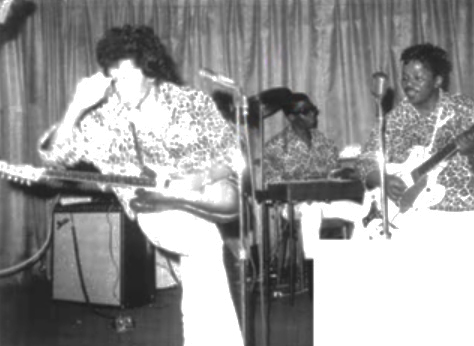
Shown above - Jimmy James playing with Curtis Knight and the Squires at the Cheetah Club, New York City 1966. Note the Maestro Fuzztone pedal on the floor in front of the Fender Twin amp
It is a fact that Mike Matthews was friends with Jimi Hendrix, going back to when he was known as Jimmy James, playing guitar in Curtis Knight and the Squires in 1966. Matthews, among other things, was a band promoter in his youth and promoted the Squires, where he met Jimmy. Later, when Jimmy (now Jimi) had his own band, Matthews was frequently invited to attended his recording sessions in New York City. Matthews has said he attended sessions in three different studios and claimed he was really proud to see Jimi using the Big Muff (Version 1) in one of those, though he has at times been a bit fuzzy on the exact year and details. I always assumed the Electro-Harmonix advertising claims meant Jimi used a Big Muff on the Electric Ladyland album, because EHX often used the words "electric lady sound" in their ads, but the dates never added up. Ladyland was recorded in 1967-68 in New York and released in September 1968. The Muff Fuzz was created in 1969 and the first version of the V1 "Triangle" Big Muff, by all reliable accounts, followed later that same year. E-H was on a roll in '69 with several Bob Myer designed circuits, including the Muff Fuzz. According to Bob, the Big Muff was the next circuit he created, and it went into production in late 1969, with a hand wired perf boarded circuit. A second edition with a PCB board and a separate on/off switch came out in 1970. At the time I write this most sources state Jimi could never have used a Big Muff simply because it is the the Big Muff date of manufacture was 1971, post dating Jimi's death in September 1970. I have seen Big Muff receipts dated from 1970 and heard many testimonials from original owners about their purchases or trades of Big Muff pedals in 1970, and even late 1969.
Shown above (L to R) - the remains Jimi's unbranded 1967 Foxey Lady pedal (from the Hendrix Experience gear collection once owned by Mitch Mitchell), the Version 1 first edition Big Muff, released in 1969, and the second edition with power switch from 1970. Both are now commonly referred to as the "triangle" Big Muff due to the control knob layout
Shown above - pedals on the floor near Jimi's feet while recording at the Record Plant in 1968. The one on the right is the same 2 knob, unbranded Foxey Lady pedal pictured above. The one on the left appears to be another Foxey Lady. These early fuzz boxes did not all sound the same, so it was common for musicians to have several of the same type in the studio to try out for the best sound.
Jimi did own one of Mike Mathew's pedals around 1968, the first version of the Foxey Lady Mike had built for Guild by Aul Instruments in 1967. One can be seen in an Eddie Kramer photo, near Jimi's feet, while recording in the Record Plant in 1968. One was also among Mitch Mitchell's collection of Hendrix Experience gear, actioned off after his death. It was technically the second version made for Guild, since the first Foxey Lady was a rebranded and reboxed Mosrite Fuzz-rite, which Hendrix reportedly also owned when he was with Curtis Knight and the Squires in 1966. Jimi may have also owned a Muff Fuzz or an Axis/Foxey Lady fuzz (the same pedal re branded) in the studio for Electric Ladyland in 1967/68, since those pedals were in production in New York at the time. Several sources also state Jimi had a Big Muff "prototype" in the studio, though that contradicts most statements Mike Matthews has made, and those sources may have been confusing it with the un branded Foxey Lady, a Black Finger prototype (see below), a Roger Mayer prototype (Jimi's guitar tech and pedal builder), or possibly one of the other prototype E-H products Mike Matthews has stated he showed to Jimi. Many people think Mike may just be mistaken about exactly which pedal he saw, although he has stated firmly in several interviews that it was indeed the Big Muff, and he saw Jimi use it in 1969 or 1970. That post dates the Electric Ladyland recording sessions, although Jimi was recording a new record in the new, but unfinished "Electric Lady" Studios in Greenwich Village, New York around in '69 and '70.
Shown above - Jimi Hendrix in the studio, Electric Ladyland album cover art
Electric Lady Studios was a project funded by Hendrix and his manager Michael Jeffery. Started in 1968, it was to be a relaxing environment exclusively for Jimi to record in. Construction permit delays, flooding, and a host of other problems delayed its completion, but it is documented that Jimi recorded in it from June 15th through August 27th 1970, during the last period of construction. Jimi did attempt an earlier session on May 14th, but decided the studio needed more work and the session was moved to the Record Plant. The studio was officially completed on August 26th 1970. Though Jimi recorded in other NY studios prior to this, I have always thought these June - August '70 sessions were the ones Mike Matthews sat in on. Here is a quote by Mike on the subject.
"...I saw Jimi using it (the Big Muff) in the studio. He used to invite me to all his recording sessions when he was in New York, and one day Henry at Manny's Music (Henry Goldrich, salesman at Manny's) told me he just sold a Big Muff to Jimi, and I went down to the studio to show him (Jimi) something else - this early version of the distortion-free sustainer (eventually sold as the E-H Black Finger) and I saw he had the Big Muff on the floor of the studio. I know early on he used Fuzz Faces, but he did eventually use a Big Muff." Mike Matthews from Guitar Effect Pedals - The Practical Handbook by Dave Hunter
Mike is also quoted another time as saying this about that session - "Jimi’s axe was plugged into an Electro-Harmonix Big Muff. Jimi rocked on that session". Other sources claim Jimi told Mike he was impressed enough with the pedal to use it on his next album. This may have been Strate Ahead, one of several proposed albums Jimi was working on in 1969 and 1970, which sadly was never completed. Some of those tracks were released on First Rays of the New Rising Sun in 1997 as well as earlier releases throughout the 1970s. I don't really hear the distinct Big Muff tone on any of these tracks, though with Jimi's playing style and other gear used, that would be very difficult to determine.
Shown above - The Arbiter Fuzz Face, one of Jimi's primary fuzz pedals
Jimi was a master experimentalist with fuzz tones and other effects available at the time (see the Fuzz and Muff Timeline for a list of all the major fuzz pedals). His first fuzz was a Maestro Fuzz-tone which he used during his time with Curtis Knight and the Squires in 1966. It is well documented that he used many pedals live and in the studio, primarily the Arbiter Fuzz Face, Vox Wah Wah, Dunlop Cry Baby wah, and Univox Uni-Vibe. Jimi also used several pedals designed by his guitar tech from 1967-68, Roger Mayer (not to be confused with Robert Myer, inventor of the Big Muff circuit), including the Octavia (Jimi called it the Octavio), first used for the guitar solo in Purple Haze in 1967 and in Fire, the Axis Fuzz used on Axis-Bold as Love (which many writers have incorrectly confused with the E-H Axis fuzz), and many other prototype fuzz pedals. According to Mayer, Jimi used over a dozen versions of the Octavio, as it was being constantly modified by him and Roger over the course of several years. Jimi also reportedly used a Marshall Supa Fuzz and a Foxx Fuzz.
He was always trying out new gear in his search for unique tones, so it is likely that he would have tried ANY new fuzz or effect pedal that was around at the time, and the place to get them when he was in New York was Manny's Music. Manny's was a world famous music gear store on 48th Street (now out of business). Electric Lady Studios was just a few miles away from Manny's, and a few miles from the Electro-Harmonix building. Though not the only music store in the area, Manny's was one of the largest on the east coast. Famous musicians from around the world, those passing through New York, and especially those recording or performing in New York like Jimi, shopped for gear there. David Gilmour of Pink Floyd, another well known Big Muff user, bought his famous Black Strat there in 1970. Manny's carried the then small line of Electro-Harmonix products and Mike Matthews was friends with owner Manny Goldrich and his son, Henry, who handled sales in the guitar showroom. Jimi was noted on several occasions to have bought guitars, pedals, and other gear there. In fact, Jimi was reportedly in the store practically every week. He bought his first wah pedal there after seeing Frank Zappa use one in a nearby club, in July 1967. Manny's had an autographed photo of him on the wall, as they had of many artists who frequented the store.
Since the issue of Hendrix using a Big Muff had stirred up so much controversy over the years, Electro-Harmonix founder Mike Matthews put down in writing everything he could recall about it and sent it to me as I was writing this article. Here is his full story about Jimi and the Big Muff (Mike originally recollected this around 2007 for a Japanese magazine article).
"Back in 1969...we plunged into production (on the version 1 Big Muff) and I brought the very first units up to Henry, the boss at Manny’s Music Store on 48th Street, NYC. About a week later, I stopped by at Manny’s to buy some cables, and Henry yelled out to me "Hey Mike, I sold one of those new Big Muff’s to Jimi Hendrix."
Now let me tell you a little history of me and Jimi. Back in the mid 60s I was a concert promoter. I had the Isley Brothers, Coasters, Drifters, Cadillacs, Lovin’ Spoonful, Young Rascals, Byrds, Turtles, Shirelles....and many more acts. I booked Chuck Berry for two nights, and was looking forward to this gig ...especially because Chuck traveled alone and the promoter had to get the back up band. I decided to play keyboards, and got some buddies of mine who mostly did Chuck Berry covers to back up Chuck. A week before the gig, that agent who sold me Chuck called me and said "Hey Mike, I need you to do me a favor and book another band.... I can give you one that will play three nights for $600." I said "Bob I don’t need another band. The crowd is coming to see Chuck Berry and I’d just be spending another $600 for nothing." Bob said "Please, I need this favor. You can have them for three nights for only $500, and they have a guy that can play guitar with his teeth." I figured, ok, and booked them, and in the future Bob owed me the next favor. The name of this band was Curtis Knight & the Squires.
When Chuck played, and me and my guys backed him up, I was a little burnt out after the first set and went to check to see how much money came in so far at the gate. Curtis Knight’s band was now playing and I didn't pay much attention until my guitarist that backed up Chuck, Steve Knapp, came running up to me and said "Hey Mike, you gotta catch this guitar player. He’s a gas." Well, that guitar player was Jimmy James. His style at the time was strictly loose R&B. We became best friends and I snuck out of my day gig several times a week, as a computer salesman for IBM, to go to his hotel room where we rapped music talk. Jimmy was quiet dude, and lived in a rundown narrow hotel room with no private toilet. He usually had his hair set with pink hair curlers.
One night I went to see him play with Curtis at a club in the upper west side called the Lighthouse. Now, Curtis Knight was a real gangster. Mainly a pimp, running a big operation. At that gig Jimmy hung with me at the breaks and told me "Mike I gotta get away from this dude. I wanna form my own band and headline it." I said "Jimmy, if you’re going to be the front man, then you have to sing." Jimmy said "Yeah, that’s the problem. I can’t sing." I said "If you really wanna sing, all you gotta do is practice and you’ll be cool. Look at Mick Jagger and Bob Dylan. they can’t sing but they can phrase their asses off and project dynamite soul." Jimmy said "Yeah, you got a good point. I’ll work on it."
Soon Jimmy formed his own band, The Blue Flame (June 1966). I went to catch them at the café Au Go Go in Greenwich Village. Sitting with me was my friend Bobby Colomby, who later on was a co-founder and drummer with Blood Sweat & Tears. He invited Eric Clapton to sit with us. Jimmy and The Blue Flames were dynamite ...still playing a loose blues style. At the break we all went across the street for some grub. The only thing Clapton kept saying again and again and again was "I just can’t believe how good this guy is. I just can’t believe it."(Editors note - A few months later Clapton would meet Jimmy (then Jimi Hendrix) for the first time on October 1st 1966, when Jimi played Killing Floor with him on stage at Central London Polytechnic, the first public performance by Cream)
Shortly after, I heard Jimmy ran off to England with the manager of the Animals (Chaz Chandler), who dug him. The rest is history, and it was in England that Jimmy became Jimi Hendrix and quickly developed his super unique electric space style. I was fortunate enough to see The Experience when they first came to New York City. Jimi called me up and said "Hey Mike come on down, I’m playing at xxxx (I forgot the name of this small club). Dynamite! (Editors note - This would have been the Scene Club on June 3rd and 4th,1967, the New York debut of The Experience.)
Whenever Jimi went into a recording studio in New York City, he invited me to hang out. I did this at three different studios, with the last one being Electric Ladyland, the one he funded and owned. Long story...Well here’s the rub. When Jimi invited me to hang at studio # 2, ( I forgot the name ) I went down to show him a new device I was working on. It was a 4 inch ceramic cased speaker that I screwed into the body of a guitar. It had small power amp. So, some portion of the guitar signal was bled into this little power amp and into the screwed in speaker which made the guitar vibrate and easy to get instant hot sustain. I took it to ask Jimi what he thought of it. When I walked into the studio, there on the floor, plugged into his guitar and amp, was the Big Muff. I told Jimi I made these and he said he just bought it at Manny’s and I said yeah, Henry told me. I then showed Jimi the guitar with the screwed in speaker with feedback circuit. He tried it and said "Hey Mike, I think you’ve got something here." (Editors note - Mike has said at other times that he showed Jimi an early version of the distortion-free sustainer, but I think those are two different occasions)
Now WHY did I tell you this whole story? Well, some time in the late 70s, a guitar magazine writer that interviewed me asked me "When did Electro-Harmonix come out with the Big Muff?" Not thinking too much about this I blurted out around 1971. Well, it was really 1969. Over the years, Hendrix purists took this 1971 date and said, Jimi couldn’t have used the Big Muff because he was gone by this time. Well, I wanted you to know the real facts."
Shown above - The old Manny's Music on 48th Street in New York City and an autographed Hendrix photo from Manny's wall
You will note that Mike said this was in 1969, so I di some digging. Electric Lady Studios was not used until June 15th 1970, but Mike said it was not that location, but the second studio Jimi recorded in for the 1969 sessions. The three Manhattan recording studios Jimi was recording in were the Record Plant, Olmstead Sound Studios, and The Hit Factory. Jimi recorded in the Record Plant and Olmstead March-May, spread across thirteen days. In late August there were three days of sessions at the Hit Factory, then there were three days of sessions in November and three days in December at the Record Plant. I have been told by one Big Muff owner that he bought his perf board Big Muff in "late 1969" when he first saw it for sale in NYC. Mike says he saw his Big Muff when he visited with Jimi in the second studio, either the Record Plant or the Hit Factory. Both were in the same neighborhood. This would have occurred between August and December 1969, which is roughly when I have determined the first Big Muff was on the market.
Though I have found little printed documentation of this other than owners receipts, I have received lots of verification over the years from Big Muff owners and sellers that the V1 Big Muff was available in early 1970, and a few people have told me they purchased their early perf board versions in NYC in late 1969. In 1967 and 1968, Rick Derringer and the McCoys were the house band at a New York City club called the Scene. The Scene was well known to be frequented by many guitar legends who recorded and performed in NYC, including Jimi Hendrix. He was friends with Rick and jammed with him there often. As I noted above, Mike Matthews said the first time he saw the Jimi Hendrix Experience perform was at this same club. Interestingly, musician Johnny Winter broke up his old band in early May 1970 and began playing with a new new lineup, The McCoys (who recorded Hang on Sloopy). An original Big Muff owner contacted me to verify he had acquired his V1 Big Muff from one of the members of The McCoys at the Orlando Pop Festival in May 1970. The McCoys were Randy Zehringer on drums, Randy Hobbs on bass, and Rick Derringer on guitar. The same Rick Derringer who jammed with Jimi regularly at the scene. That is just one of several accounts I have heard that indicates the Big Muff was being used by musicians in this period.
If Jimi bought a Big Muff as Henry from Manny's recollected, and had one in the studio in 1969 as Mike recollected, this easily fits into a window of almost 18 months before Jimi's death. But memories may get a bit dodgy or foggy about events that occurred over 30-40 years in the past, and it may be easier to recall a significant event more so that the exact date the event occurred. Heck, I can't remember exact year I bought certain pedals within the last ten years or so. So, for the sake of argument lets say it was only available in May 1970 (the earliest receipt date I have seen) that is still around four months, giving Jimi plenty of time to have bought and used one in the studio.
The legend that Jimi's well known tone came from the Big Muff would not be an accurate statement however. An Electro-Harmonix brochure from 1977, shown below, makes the claim that the Big Muff was the pedal Jimi Hendrix relied on for his “electric-lady” sound. This was likely more of a reference to the Electric Lady Studios, not the record, but E-H was no doubt trying to capitalize on the Hendrix fame with this association, as had been done previously with the E-H pedals named "Axis" and "Foxey Lady". Although it is probably not the best pedal to use for most Hendrix tones, the Big Muff was certainly inspired by the Hendrix fuzz tone, as Mike Matthews has stated several times, and it does get you into similar fuzz tones at the right settings with a Stratocaster and certain amps. Whether or not any recordings exist of Jimi using it, we will probably never know. None of my research has turned up any actual syudio photos of documentation. If Jimi did use one, it would be on one of the songs recorded in those last few months in 1969 through 1970. Songs Jimi recorded in those sessions were Midnight, Trash Man, Ships Passing in the Night, Ezy Ryder, Hear My Train a Comin, Keep on Groovin, Freedom, With the Power of God, Earth Blues, Bleeding Heart, Message from Nine to the Universe (Earth Blues and Message to Love joined), Message to Love, Lover Man, Message To The Universe, Izabella, Burning Desire, Easy Blues, Beginnings, Machine Gun, Sky Blues Today, Mastermind, Room Full Of Mirrors, Stepping Stone, Dolly Dagger, Them Changes, and Power of Soul.
Unfortunately there are no studio records or photos that have ever surfaced to verify its use, so the Hendrix Big Muff mystery will have to remain a mystery. It would have been interesting to hear what sounds Jimi would have recorded with this pedal, or the later versions, had he lived.
Shown above - An E-H brochure from 1977 citing the Big Muff as pedal Jimi Hendrix relied on for his "electric-lady" sound. The Big Muff was likely for sale in late 1969 and certainly by 1970 at Manny's Music, located a few miles from the various Manhattan studios where Jimi was recording in the 18 months prior to his death.
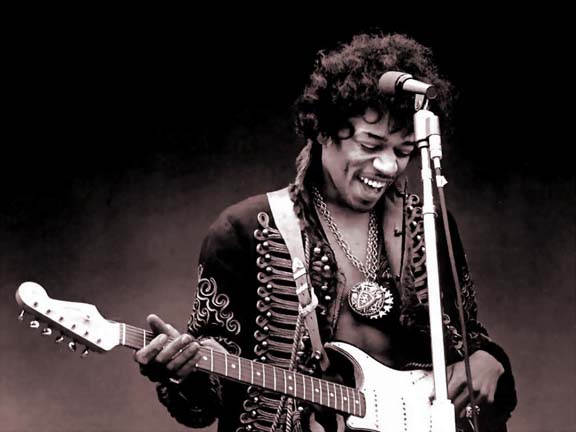
CONTINUE - BACK TO THE HISTORY OF THE BIG MUFF PART 1 (Vintage USA)
HISTORY OF THE BIG MUFF PART 2 (Russian)
HISTORY OF THE BIG MUFF PART 3 (modern USA)
Copyright Kit Rae. This page is not authorized, affiliated, or associated with Electro Harmonix in any way (but it would be cool if they had a link to this page)
Website and contents ©2007 and ©2011 Kit Rae. All rights reserved. Linking to this website is allowed, but copying the text content is strictly prohibited without prior authorization. No part of this work may be reproduced, stored in a retrieval system, or transmitted in any other form, or by any means, electronic, mechanical, photocopying, recording, computer networking, or otherwise without prior permission in writing from the copyright holder(s).
